Looking for fresh drawing ideas? Nature offers endless inspiration, from spring flowers to winter snowscapes. Try urban sketching to capture city life with quick, expressive lines. The human body provides fascinating challenges with its movement and emotion. Fantasy art lets imagination soar, while everyday objects reveal hidden beauty. Colors can express feelings—fiery reds for passion, cool blues for calm. Even 10-minute daily sketches build skills and unleash your creative voice. These pathways lead to artistic discovery!
Key Takeaways
- Explore seasonal changes in nature by sketching first spring tulips, summer beach scenes, colorful fall leaves, or winter snowflakes.
- Practice urban sketching to capture city life and architecture, which improves perspective skills and creates visual diaries.
- Use color deliberately to express emotions through bold reds for passion, cool blues for calm, or contrasting hues for conflict.
- Try 10-minute daily drawing challenges to break creative blocks, fitting artistic practice into busy schedules without perfectionism.
- Develop fantasy art by blending cultural traditions and exploring magical realms beyond everyday life with no wrong answers.
Nature’s Living Canvas: Botanical Drawing Inspirations
Often overlooked yet bursting with potential, the natural world offers artists a living, breathing palette of inspiration through botanical drawing. From the delicate veins running through a leaf to the bold colors of wildflowers, plants provide endless subjects for creative exploration.
Artists who take time to observe the tiny details—like the fuzzy texture of moss or the spiral pattern of a fern unfurling—develop sharper observation skills and unique artistic perspectives. Seriously, have you ever really looked at a pinecone? It’s mind-blowing!
Botanical drawing changes with the seasons too. Spring brings fresh blossoms, while fall delivers those amazing red and orange leaves.
Plus, connecting with nature through art helps people appreciate the environment more. Who knew that drawing a simple dandelion could make you feel so connected to the earth?
Urban Sketching: Capturing City Energy and Architecture

Skyscrapers, street vendors, and bustling crowds create a vibrant playground for artists who venture into urban sketching. This dynamic art form challenges creators to capture the pulse of city life through quick, expressive drawings that tell stories of everyday moments and architectural wonders.
| Creative Drawing Prompts | Benefits | Techniques |
|---|---|---|
| Coffee shop corner views | Improves perspective | Quick gesture lines |
| Street performers in action | Captures movement | Light and shadow contrasts |
| Historic vs. modern buildings | Develops storytelling | Simplified architectural details |
Urban sketching isn’t just about pretty pictures—it’s about freezing moments in time! Artists learn to observe the interplay between organic human movement and structured environments, creating a visual diary of city experiences. These sketches become treasured snapshots of places visited and stories witnessed, all while building essential artistic skills through regular practice.
The Human Form: Expressive Figure Drawing
While urban scenery offers endless drawing opportunities, the human body presents artists with perhaps the most fascinating subject of all. Figure drawing captures not just what we look like, but how we move and feel!
Artists who watch real models can spot tiny details—the way shoulders tense during a stretch or how weight shifts on one leg—that bring their drawings to life.
Playing with light and shadows makes bodies pop off the page, turning flat sketches into 3D masterpieces.
The coolest part? Trying different poses—dramatic lunges, quiet seated moments, or dynamic twists—helps artists level up their skills.
Even beginners can grab pose references or join a drawing class to practice. The human form might seem tricky at first, but it’s totally worth the effort!
Mythical Realms: Fantasy and Folklore Art Ideas
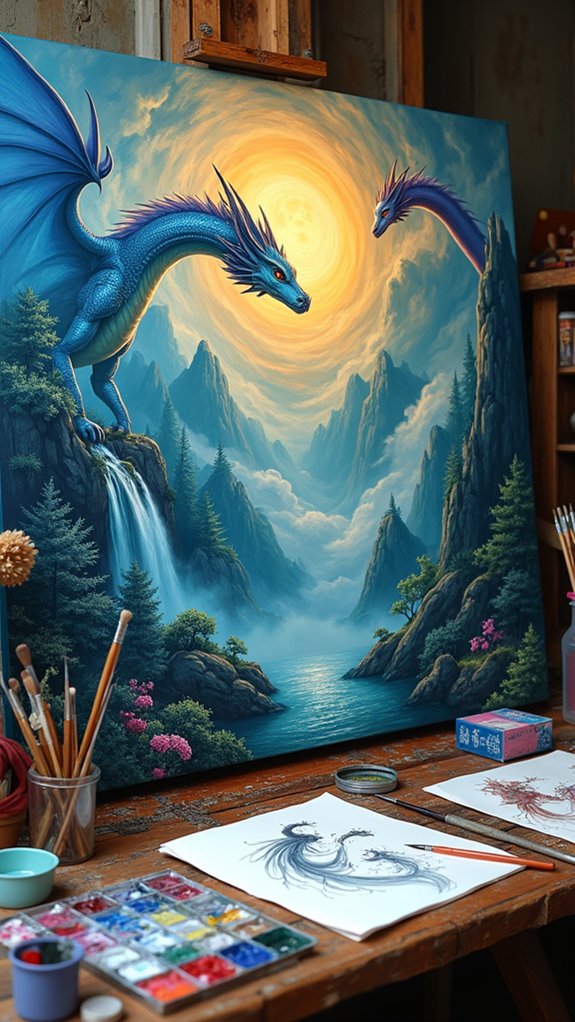
Beyond the everyday world lies a universe of magical possibilities for artists to explore through fantasy and folklore drawing. Dragons soaring over misty mountains, fairies dancing among mushroom circles, and ancient heroes battling mythical beasts all spring from the creative mind’s eye.
Artists who immerse themselves in mythical domains can blend elements from different cultural traditions, creating entirely new fantasy worlds that still feel somehow familiar.
Try these drawing prompts: sketch a fairytale village hidden in a forest, illustrate a modern character encountering a creature from folklore, or reimagine a classic myth in your own unique style.
The beauty of fantasy art is that there are no wrong answers—just endless opportunities to transform imagination into visual storytelling that captivates and enchants viewers of all ages.
Wildlife Wonders: Animal Drawing Techniques
Stepping from the realm of imagination to the natural world, artists discover that wildlife offers its own kind of magic. Capturing the essence of animals requires both observation and technique, as artists study creatures in their natural habitats to understand their unique movements and forms.
Successful wildlife art often begins with focused practice on specific features—the piercing gaze of an eagle’s eye or the delicate architecture of a fox’s paw.
Artists who spend time at zoos or poring over photographs notice how a lion’s mane catches light or how a bird’s feathers overlap.
Different drawing techniques, from colored pencils that highlight a chameleon’s vibrant patterns to watercolors that capture the fuzzy texture of a bear cub, bring these wild subjects to life on paper.
What amazing creature will you draw today?
Dynamic Motion: Illustrating Movement in Still Images
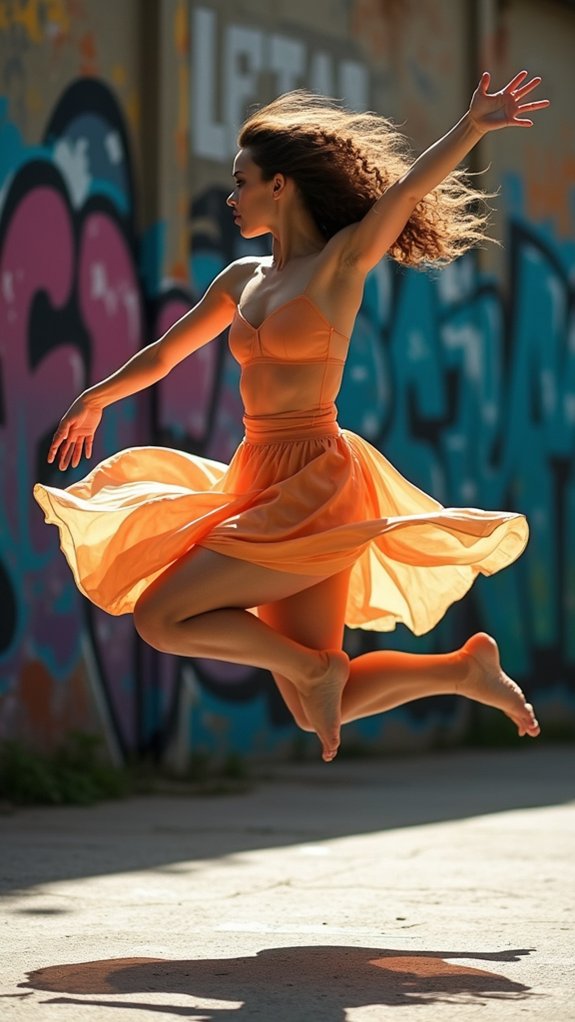
Creating artwork that captures movement is like freezing a moment in time while still showing what happens before and after.
Artists can learn to show motion by watching quick actions in real life, like birds taking flight or athletes jumping, focusing on capturing the dynamic energy through fast gesture drawings.
Once you understand how bodies move, you can add flowing energy lines that tell viewers’ eyes where to follow, turning a flat drawing into something that seems to leap right off the page.
Catching Action Mid-Flight
When an artist captures movement in a still image, they freeze time and tell a story that pulses with energy. Artists with developed drawing skills can make birds soar and dancers twirl on paper, bringing static images to vibrant life!
To catch action mid-flight, artists often study videos of athletes or animals in motion. They look for that perfect moment—when a basketball player hangs in the air or a cat springs toward its toy. Using blurred lines or dynamic poses creates the illusion of speed, pulling viewers’ eyes through the artwork like a rollercoaster!
Different mediums offer unique advantages too. Charcoal smudges can suggest a runner’s path, while loose watercolor strokes might capture a fluttering butterfly. It’s all about finding the flow and rhythm that makes viewers feel the whoosh of movement!
Gesture Drawing Essentials
Every great action drawing begins with an essential foundation: gesture drawing. Artists use these quick sketches to capture movement and energy, rather than getting lost in tiny details. The magic happens when you work fast—usually under two minutes per sketch!
| Quick Tips | Why It Works |
|---|---|
| Use swooping lines | Creates natural flow |
| Draw the “line of action” first | Establishes dynamic pose |
| Keep your pencil moving | Maintains energy |
| Vary your poses | Builds versatility |
| Focus on weight distribution | Makes figures believable |
When practicing gesture drawing, imagine you’re tracing the energy flow through the body. It’s like catching lightning in a bottle! Regular practice transforms stiff drawings into lively ones that practically jump off the page. Your sketches will thank you!
Rhythmic Energy Lines
Moving beyond basic gesture sketches, rhythmic energy lines breathe life into artwork. These dynamic marks capture the invisible forces that make subjects feel alive and in motion.
Daily drawing practice with flowing, curved lines helps artists develop an intuitive feel for movement.
When observing subjects in action, notice how energy ripples through them—like leaves dancing in the wind or a runner’s muscles tensing and releasing. Try varying your line thickness to show speed (thinner for faster parts) and direction. So cool, right?
Artists can also create awesome motion trails by overlapping lines or adding a touch of blur. This tricks the eye into “seeing” movement, even though the drawing is totally still!
Nature offers the best examples—watch how water splashes or birds soar for inspiration.
Emotional Landscapes: Drawing to Express Feelings
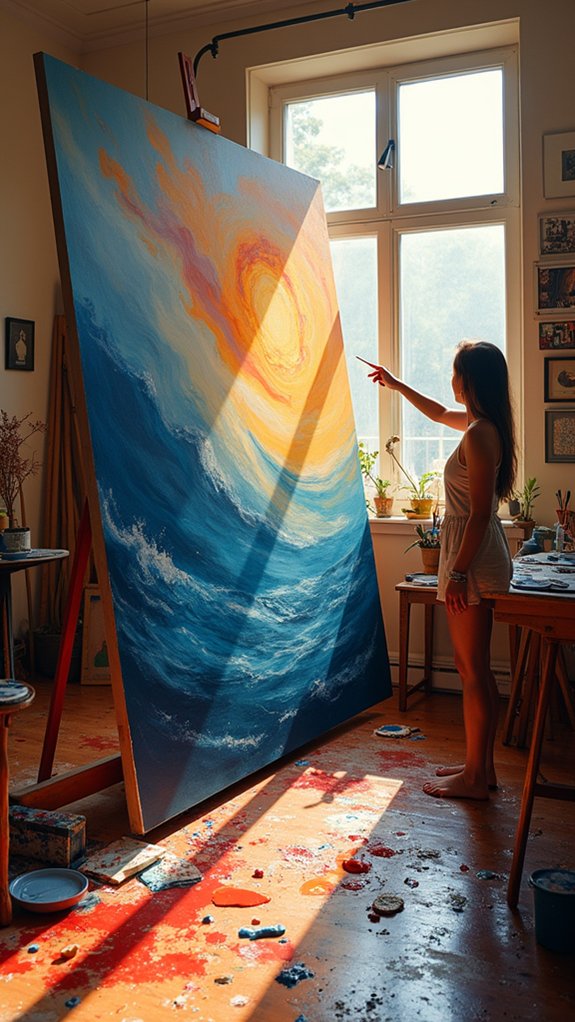
Creating emotional terrains through drawing offers a powerful way to express feelings that might be hard to put into words.
Artists can use colors like fiery reds or calming blues to show emotions, while sketching their inner worlds helps them make sense of complicated feelings.
Through symbolic elements—like a winding path representing life’s journey or a broken tree signifying loss—artists transform their personal experiences into visual stories that speak to others who might be going through similar emotions.
Emotions Through Color
Many artists discover that color serves as a powerful language for expressing feelings that words simply cannot capture. When painters dip their brushes into bold reds and fiery oranges, they’re actually translating passionate emotions onto paper!
Similarly, cool blues and calming greens can instantly make viewers feel peaceful or melancholy.
Emotions through color isn’t just about random choices—it’s a deliberate storytelling technique. Artists might use stormy purples and grays to show inner turmoil, or sunny yellows to radiate happiness.
Even the way colors blend together can mimic emotional states: sharp contrasts for conflict, harmonious shifts for contentment.
The coolest part? Everyone connects with these color-emotions differently, making each setting a personal conversation between the artist and viewer.
Next time you’re feeling stuck, try letting your emotions pick your palette!
Sketching Inner Worlds
The artist’s mind contains hidden vistas that long to emerge through pencil and paper. These emotional terrains transform feelings into visible stories that anyone can understand. When artists dig into their memories and personal experiences, they create drawings filled with power and truth.
Think of your sketchbook as a diary that uses shapes instead of words! Try layering textures—smooth, rough, spiky—to show different emotions. Feeling frustrated? Scribble hard with reds and oranges. Peaceful? Flow with gentle blue curves. It’s like being a feelings detective!
Regular sketching sessions become a kind of therapy, helping artists understand their own emotions better. The coolest part? There are no mistakes when you’re mapping your inner world—just honest expression and awesome discoveries!
Symbolic Self-Expression
Every artist discovers their own visual language when creating emotional vistas on paper. Through symbolic elements like stormy clouds or peaceful meadows, artists transform their feelings into powerful visual stories.
This translation of emotions into art helps viewers connect with experiences that might be tough to put into words.
- Fiery reds and jagged lines can express anger or passion, while soft blues create calm.
- Personal symbols, like a specific flower or animal, add deeper meaning to your drawings.
- Changing your line thickness—thin for delicate feelings, bold for intense ones—speaks volumes.
- Weather elements (rain, sunshine, fog) instantly communicate different emotional states.
- Empty space isn’t just blank—it can represent loneliness or create breathing room in busy emotions.
Daily Drawing Challenges: 10-Minute Creative Exercises
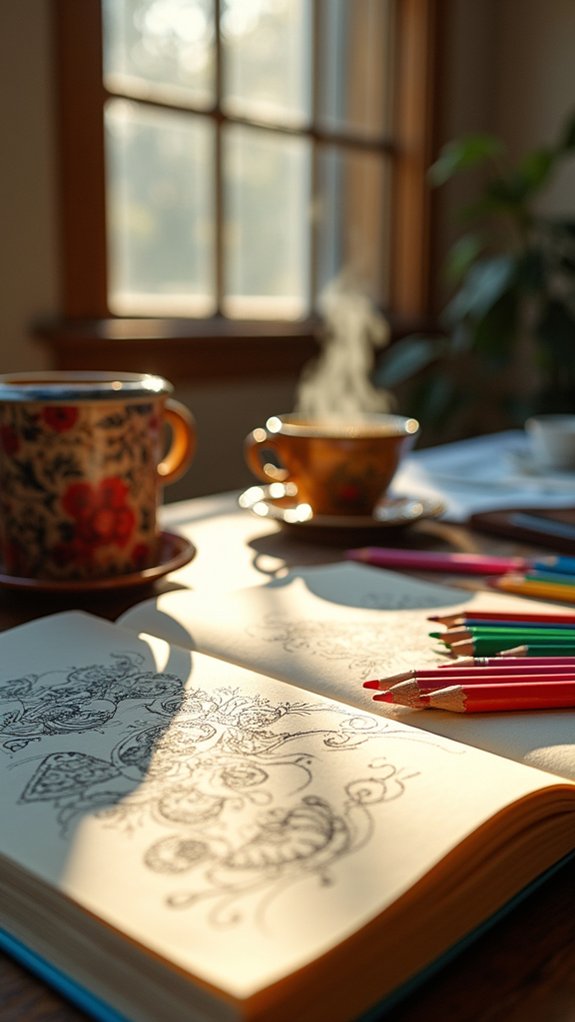
Why not transform artistic growth into bite-sized adventures? Daily drawing challenges that last just 10 minutes can spark creativity while fitting into the busiest schedules.
These quick sessions become powerful tools for breaking through creative blocks and building consistent artistic habits. Artists can use these mini-challenges to experiment wildly with new techniques they’d normally avoid. One day might feature sketching a household object from memory, while the next could involve capturing a pet in motion using only five lines!
The beauty of these exercises lies in their simplicity—grab a pencil, set a timer, and plunge into it!
Over time, these short bursts of creativity stack up, revealing surprising improvements in observation skills and drawing confidence. Plus, the time limit keeps perfectionism at bay, allowing pure creative joy to flow.
Dreamscapes and Surrealism: Unlocking Subconscious Creativity
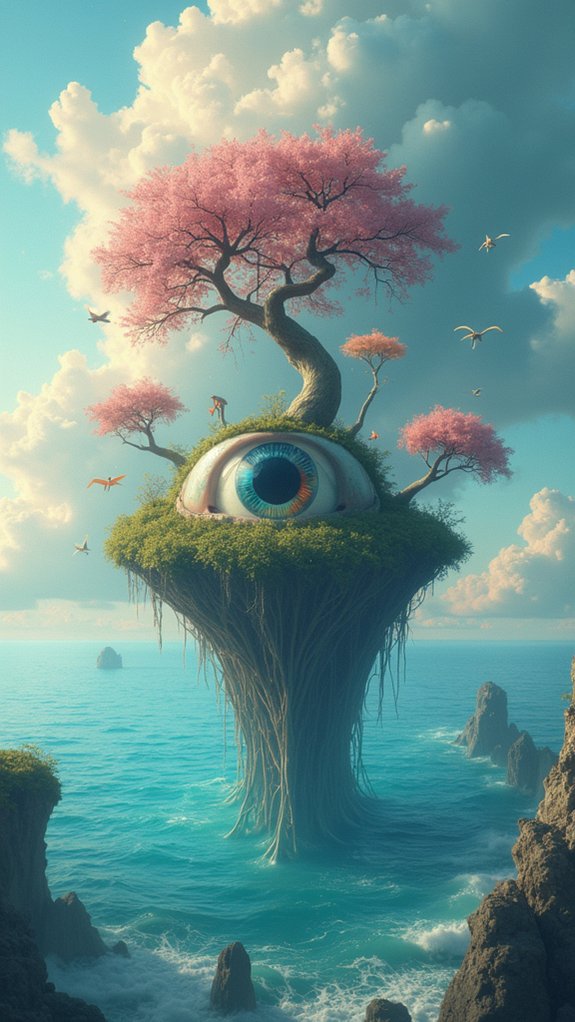
Dreamscapes and surrealism offer artists a magical playground where the rules of reality don’t apply, as famously seen in Salvador Dalí’s iconic melting clocks that bend time itself.
Many artists keep dream journals beside their beds, quickly sketching strange visions before they fade away like morning mist, capturing seeds for future masterpieces.
The real fun begins when artists mix impossible elements together—like floating elephants with spider legs or doorways opening into oceans—creating mind-bending scenes that make viewers question what’s real and what’s imagined.
Salvador Dalí’s Melting Clocks
Few artists have captured the imagination quite like Salvador Dalí, whose melting clocks have become one of the most recognizable images in modern art.
His masterpiece “The Persistence of Memory” invites viewers into a dreamlike world where time literally bends and warps. For young artists seeking drawing prompts, Dalí’s surrealistic approach opens doors to unlimited creativity.
- Try drawing your favorite object as if it’s melting in the sun
- Combine two completely unrelated items in one impossible scene
- Sketch a scenery that exists half in reality, half in dreams
- Create a self-portrait where parts of your face are replaced with objects
- Imagine and illustrate what time would look like if it were visible
Dream Journaling for Artists
When artists reach for their sketchbooks before the morning’s first stretch, they’re tapping into a goldmine of creativity that most people simply let fade away.
Dream journaling captures those weird, wonderful visions that visit during sleep, turning them into fuel for amazing artwork.
Artists who regularly document their dreams discover hidden treasures in their subconscious mind.
These dream-inspired creations often blend reality with impossible scenes, like trees growing upside down or oceans in the sky.
Surrealist painters have used this technique for years!
Juxtaposing Impossible Elements
Moving from the morning’s dream journal to the artist’s canvas, the magic truly begins to happen. The creative process reveals itself when artists start juxtaposing impossible elements, placing things together that could never exist in our waking world.
Surrealism thrives on these wild combinations – fish swimming through cloudy skies or melting clocks draped over tree branches.
- Try combining human features with plant life, like fingers blooming into flowers
- Place everyday objects in bizarre settings, such as a telephone melting in a desert
- Experiment with impossible physics – staircases leading nowhere or buildings floating upside-down
- Mix scale dramatically by making tiny things enormous and huge things miniature
- Blend different time periods in one scene, like dinosaurs roaming modern cities
Themed Art Journaling: Visual Storytelling Through Drawing
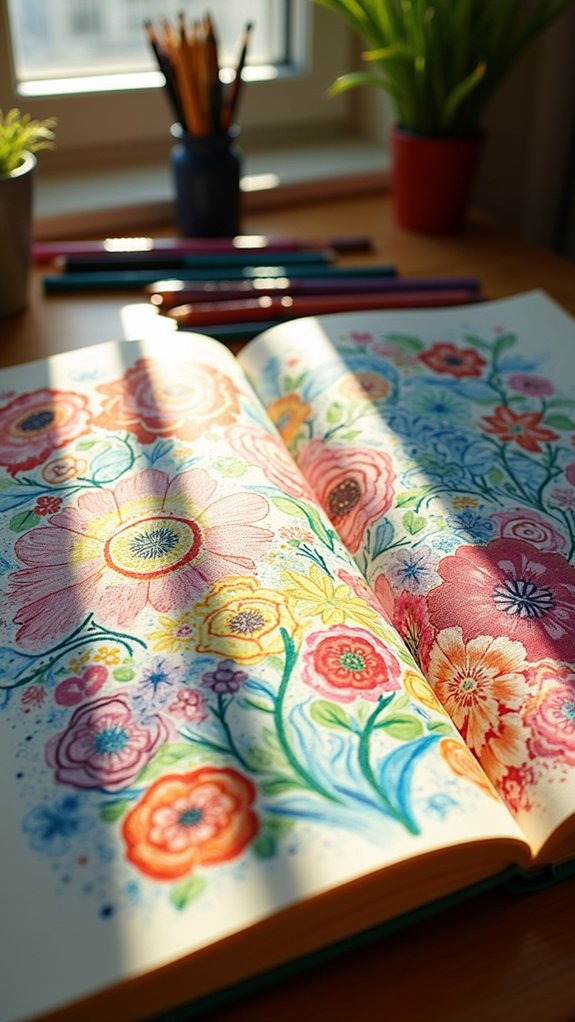
The magic of themed art journaling lies in its power to transform blank pages into vibrant visual stories. Artists combine drawings, colors, and personal narratives on themed pages, creating a tapestry of emotions and experiences.
These journals become both artistic playgrounds and emotional sanctuaries, where creative expression flows freely through drawing prompts that spark imagination.
When stuck in an artistic rut, themed art journaling offers a lifeline! By selecting themes like “childhood memories” or “dream worlds,” artists can plunge into structured creative adventures that break through mental blocks.
The combination of visuals and storytelling creates a unique language that speaks volumes beyond words alone. Plus, flipping through completed journal pages later becomes like revisiting old friends—each spread telling its own colorful story of who you were when you created it.
Cultural Motifs: Drawing Inspiration From Global Traditions
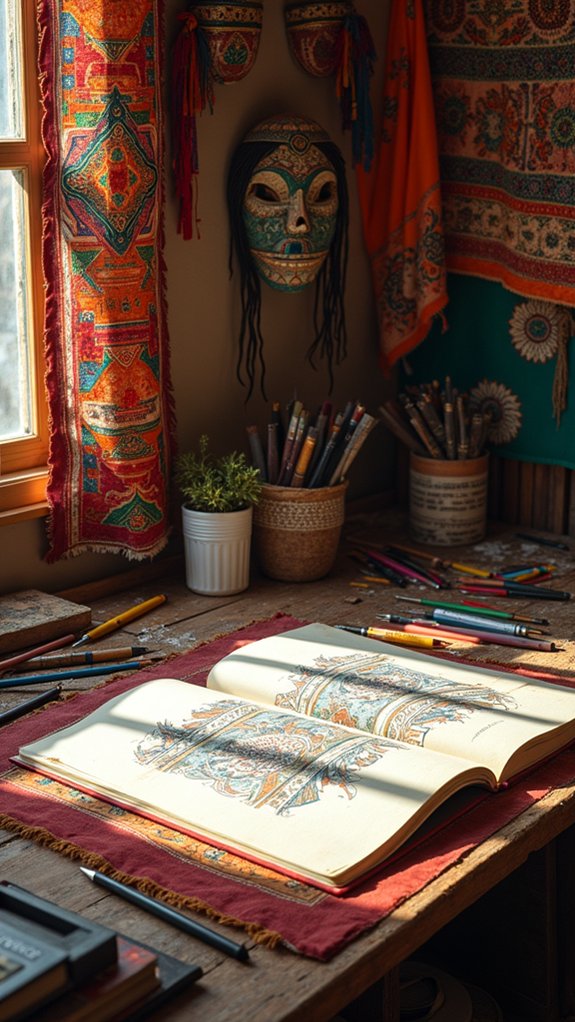
Beyond personal journaling lie vast treasures of inspiration waiting in the colorful tapestry of global traditions.
Artists looking to refresh their creativity can explore cultural motifs from around the world, bringing rich heritage into their work. These diverse inspirations breathe new life into drawings and connect artists to centuries of artistic wisdom.
- Try incorporating the geometric patterns of African textiles into your background designs
- Sketch characters wearing traditional costumes that tell stories of their heritage
- Draw scenes from vibrant cultural festivals like Day of the Dead or Diwali
- Include iconic landmarks as settings to give your art a sense of place
- Study traditional crafts like origami or pottery to inspire new techniques and patterns
Everyday Objects: Finding Beauty in the Mundane
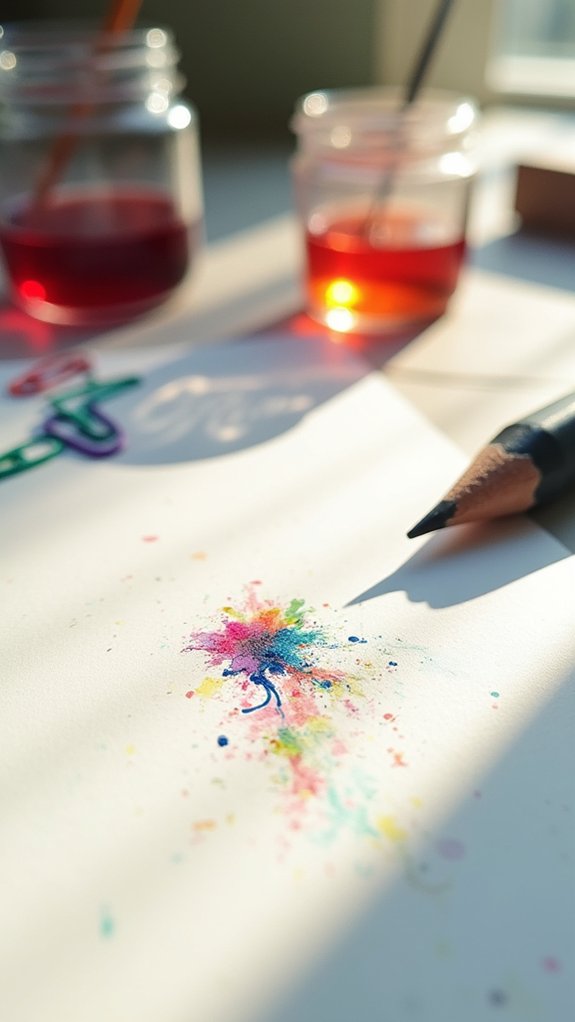
Artists can uncover hidden stories in the most ordinary household items, transforming their quiet presence into visual tales worth telling.
When we look closely at familiar shapes—a well-worn coffee mug, a vintage camera, or even a simple paperclip—they become fresh canvases for creative exploration, their curves and angles suddenly fascinating under artistic scrutiny.
The play of light across textured surfaces creates dramatic shadows that breathe life into otherwise overlooked objects, revealing an unexpected beauty that’s been sitting on our shelves all along.
Hidden Narratives Unfold
Three seemingly ordinary objects can hold extraordinary stories when viewed through an artist’s eye. A teapot might reveal a family’s Sunday traditions, while a pair of worn sneakers could map adventures across continents.
Artists who study everyday life discover that simple items aren’t just functional—they’re storytellers, waiting for someone to translate their tales onto paper or canvas.
- A vintage alarm clock might represent the passage of time in someone’s life
- An old hairbrush could reveal patterns of use and care from its owner
- A chipped coffee mug might hold memories of countless morning conversations
- A well-used kitchen spoon might tell stories of family recipes passed down
- A tattered book might showcase a journey of imagination and learning
Familiar Forms Reimagined
Many ordinary objects we encounter daily hide extraordinary artistic potential when viewed with fresh eyes. A humble paperclip, coffee mug, or kitchen whisk transforms into fascinating drawing prompts when artists observe their unique curves, shadows, and textures.
Kids can challenge themselves by sketching these items from unusual angles—maybe from above, below, or super close up!
The magic happens when everyday items are reimagined through different artistic lenses. Try capturing a stapler with watercolors, or a hairbrush using only ink lines!
This approach not only develops essential observational skills but teaches artists to find beauty in the mundane stuff around them. By exploring familiar forms, young artists discover that inspiration isn’t hiding in faraway places—it’s sitting right there on their desk, just waiting to be seen differently.
Texture and Shadow
Every ordinary object has a secret life revealed through light and shadow.
Artists who pay close attention to these elements can transform even the most mundane kitchen utensils or dusty books into fascinating subjects.
The interplay between texture and shadow creates depth that brings drawings to life, turning the everyday into something extraordinary.
- A ceramic mug’s smooth surface captures light differently than a rough wooden spoon
- Shadows falling across book pages create dramatic contrasts worth exploring
- Changing your viewing angle reveals hidden textures you’ve never noticed before
- Light hitting metal objects creates striking highlights and deep shadows
- The worn edges of old furniture tell stories through their unique texture patterns
Seasonal Drawing Prompts: Capturing Time’s Essence
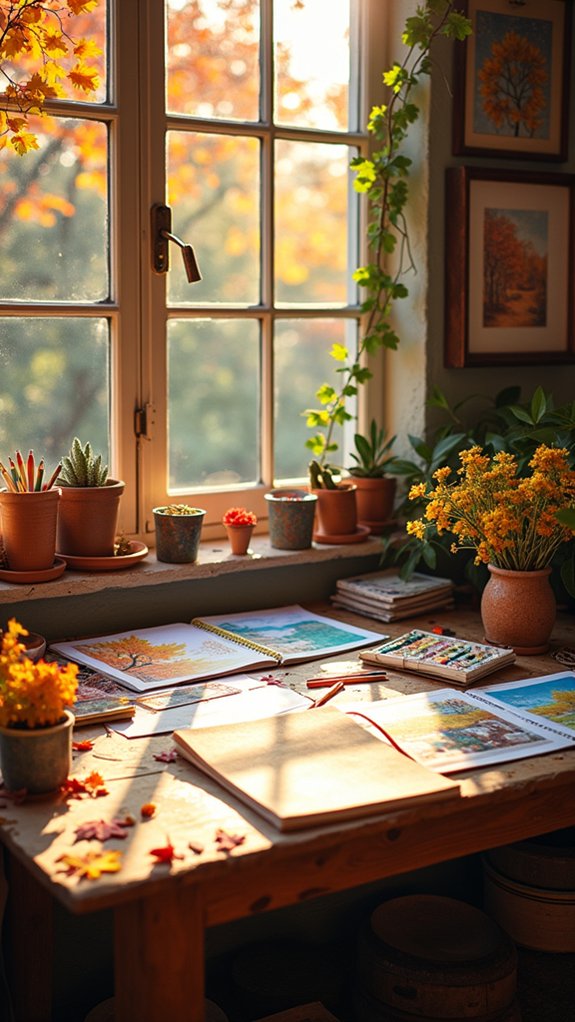
As the world transforms through the rhythm of changing seasons, artists find a boundless well of inspiration in nature’s ever-shifting canvas.
Seasonal drawing prompts offer a fantastic way to tune into these changes, challenging artists to notice the tiny details that make each season special.
Imagine sketching spring’s first tulips pushing through the soil, or a summer beach scene with shadows dancing across hot sand!
Fall brings those impossibly colorful leaves that practically beg to be drawn, while winter offers the chance to capture that magical moment when snowflakes land on mittens.
These prompts aren’t just fun—they’re like artistic time capsules that help develop observation skills and connect emotions to visuals.
Talk about drawing with feeling!
Material Exploration: Mixed Media Drawing Techniques
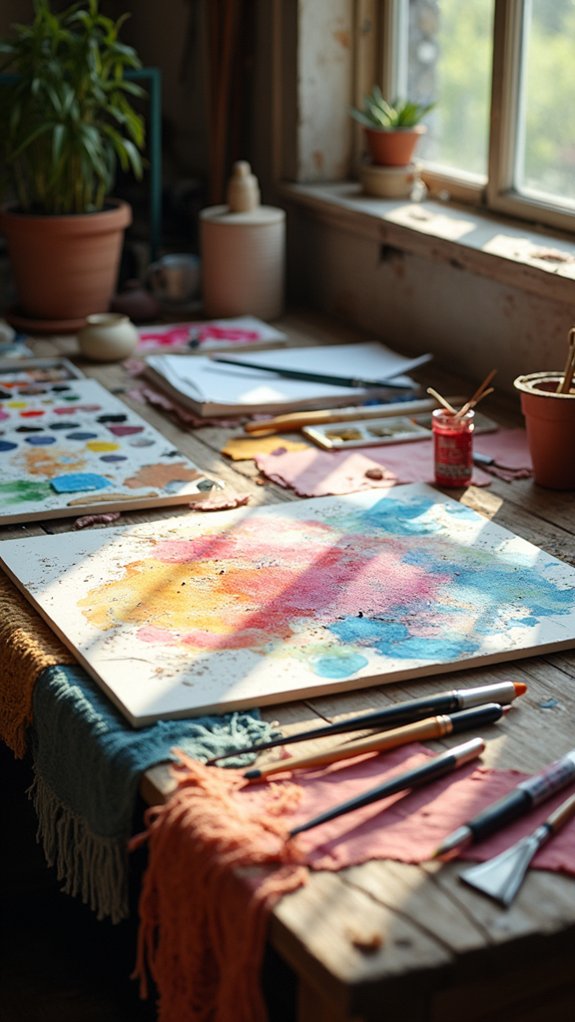
When artists feel limited by just one drawing tool, mixed media techniques open up a whole new world of creative possibilities!
By combining different materials like watercolors, ink, pastels, and markers, young artists can create artwork with amazing textures and depth. Mixed media drawing techniques encourage experimentation and happy accidents that might lead to discovering a unique artistic style.
Explore beyond your comfort zone by mixing materials—where limitations fade and artistic discoveries await.
- Try layering transparent watercolor under bold marker lines for a cool contrast
- Use white gel pens over darker backgrounds to make stars, highlights, or details pop
- Press leaves or textured objects into wet paint for natural imprints
- Incorporate torn magazine pieces for instant color and pattern
- Apply masking tape before painting, then remove it for crisp, straight edges
Digital Drawing: Creative Possibilities in the Digital Realm

The digital world has revolutionized how young artists can bring their imaginations to life! With digital drawing, artists can create amazing artwork using special software that lets them experiment without fear. Messed up a line? No problem! The magical undo button saves the day, unlike when you’re using regular paper.
One of the coolest things about creative possibilities in the digital domain is using layers to build artwork piece by piece. It’s like having invisible sheets stacked on top of each other that you can change separately!
Digital brushes can mimic everything from squishy paint to scratchy pencils, and you don’t even need to clean up afterward. Plus, when you finish your masterpiece, you can share it online instantly and connect with other artists around the world for feedback and inspiration!
Frequently Asked Questions
How Do You Spark Creativity When Drawing?
Creativity emerges when one engages in visual meditation, observes surroundings attentively, experiments with diverse mediums, draws from personal experiences, and participates in structured challenges that expand artistic boundaries.
How Do You Come up With Creative Drawing Ideas?
Artists generate creative drawing ideas through visual journaling, collecting observations, emotions, and spontaneous sketches. They combine personal experiences with imaginative elements while exploring diverse themes and engaging with their surroundings.
What Can an 11 Year Old Draw?
Eleven-year-olds can explore character design through cartoon figures, animals, self-portraits, and nature studies, developing observation skills while expressing creativity with different poses, expressions, and environmental details.
Which Drawing Is Trending Now?
Current trending drawings include whimsical themes like magical gardens, fantasy creatures, urban vistas, and emotional artworks. Digital illustrations incorporating these elements are particularly popular across social media platforms and art communities.
Conclusion
Drawing inspiration lives all around us—from towering trees to busy city streets, even in the most ordinary objects. By exploring these nine creative pathways, young artists can break through creative blocks and discover fresh ideas that spark their imagination. Remember, the best drawings often start with an open mind and curious eyes. So grab those pencils, try something new, and watch your artistic skills bloom in unexpected ways!

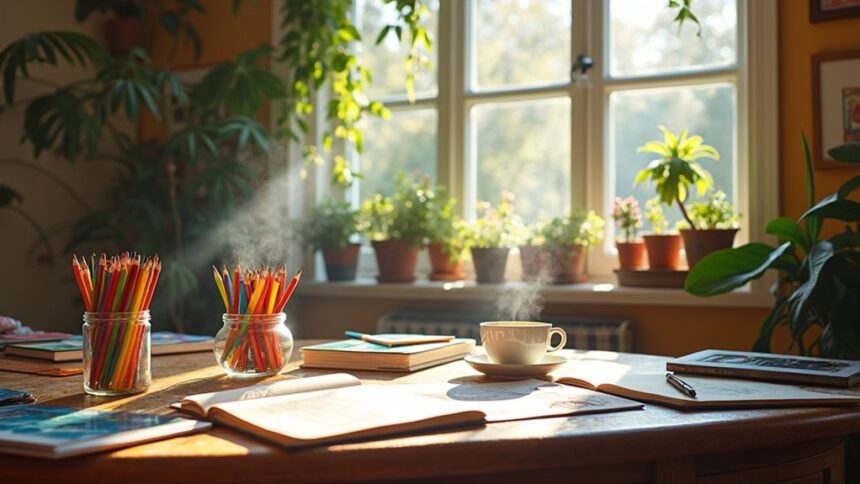
Leave a Reply